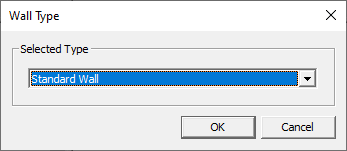Specify Wall Type in Indoor Database

Figure 1. The Wall Type dialog.
- Standard Wall
- Define the selected object as a standard wall.
- Topography Triangles
-
Include vector topography data in an indoor database by setting the object to Topography Triangles.
As an example, this can be convenient to model a traffic situation with elevation differences. The traffic and other objects are in an “indoor” database (.idb file) purely to have geometrical freedom to work with arbitrary object shapes. The ground, a collection of connected triangles that approximate the elevation pattern, may be part of the imported geometry, or be converted from another file and combined with the aforementioned database. The default setting for the ground triangles, like any objects in WallMan, will be “standard wall”. That has a disadvantage if the ground is not level: in ProMan it will not be possible to define a display height and a prediction height at a constant distance from this ground. By changing the wall type of the ground triangles to Topography Triangles, the disadvantage is removed: both the display height and prediction height in ProMan can be defined relative to this ground, and will follow it up and down as needed.
For this assignment, all ground triangles need to be selected. If you have many, and if they have a unique material, it is convenient to create a "group" of objects by material, select the group and then change the wall type for all triangles at once.
If objects were grouped, the grouped objects must first be disintegrated before the .idb file can be saved. Click to disintegrate the group.
- Graphical Wall (not considered in prediction)
- Define the selected object as a wall that is not considered in predictions.
- Prediction plane
- Define the selected object as a prediction plane to be used to simulate wave propagation predictions on the surface of the object. The object can be any arbitrary defined polygonal object.